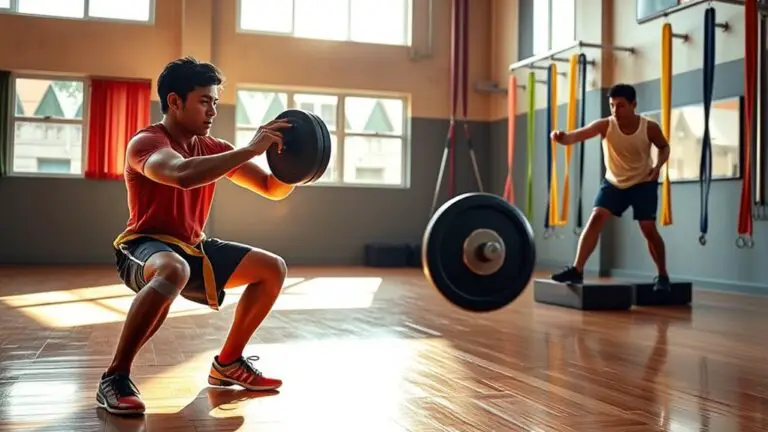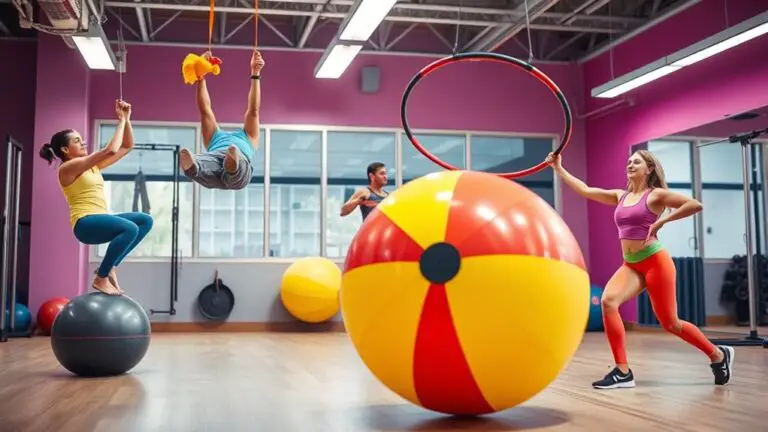Stair Climber vs. Treadmill: Which One Is More Effective?
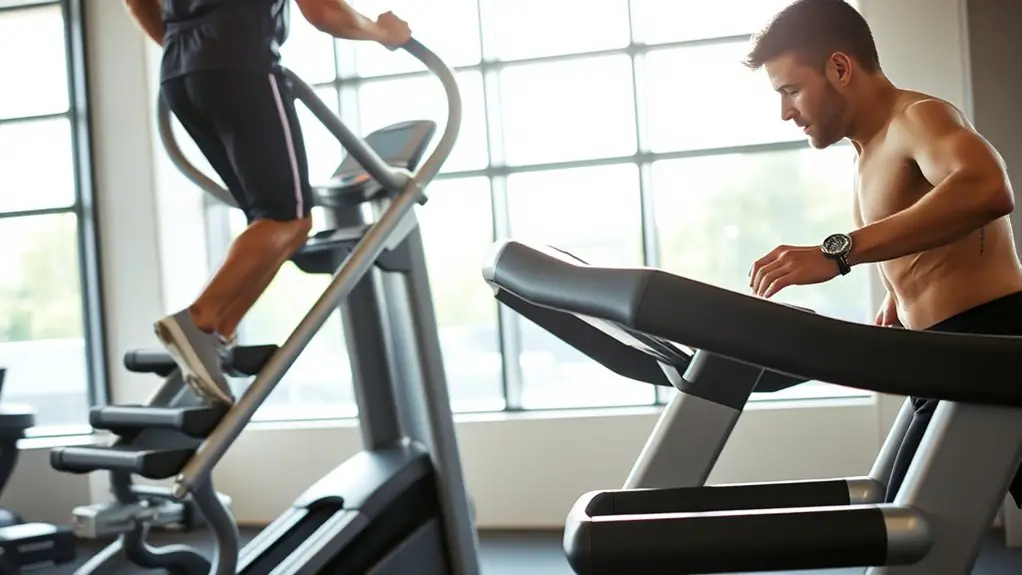
When deciding between a stair climber and a treadmill, consider your fitness goals and joint health. Stair climbers engage more muscle groups and offer a low-impact workout, making them great for building strength and endurance. Treadmills provide varied speeds and inclines, ideal for beginners and general cardio. Both have unique benefits, so it’s important to think about your preferences and space. There’s more to explore about these machines to help you make the best choice for your workout routine.
Overview of the Stair Climber
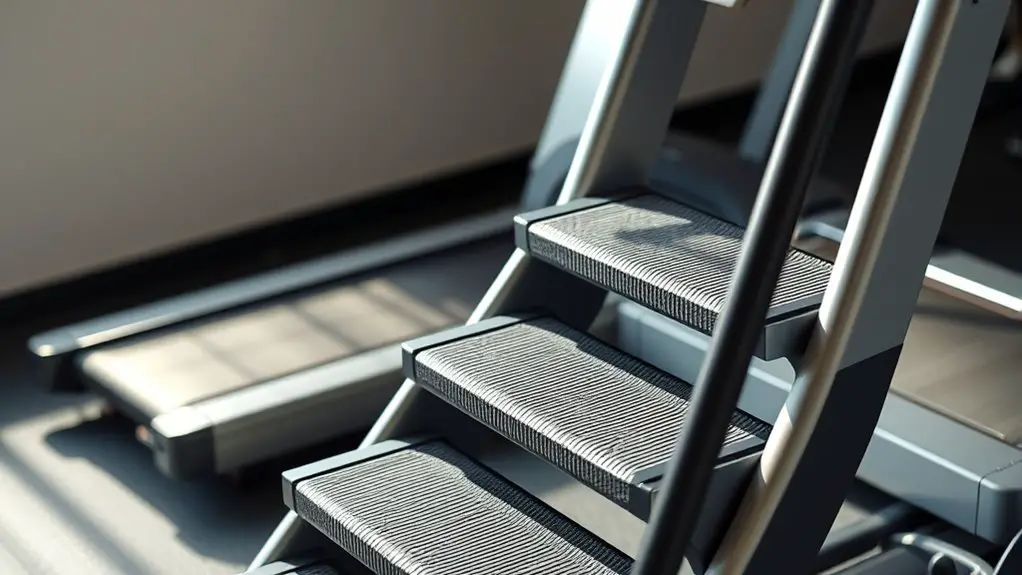
When you think about effective cardio workouts, the stair climber often stands out as a powerful option. It offers numerous stair climber benefits, including improved cardiovascular health, muscle toning, and increased calorie burn. This machine mimics the action of climbing stairs, engaging multiple muscle groups, particularly in your legs and core.
One of the key aspects of using a stair climber is the ability to adjust the workout intensity. You can easily modify the resistance and speed to suit your fitness level, making it a great choice for beginners and advanced users alike. Plus, because it’s a low-impact exercise, it minimizes stress on your joints, allowing for a safer workout experience. Just remember to maintain proper posture and grip the handles lightly. With consistent use, you’ll likely notice improvements in your endurance and overall fitness, all while enjoying the benefits of an effective cardio session.
Overview of the Treadmill
While the stair climber effectively targets lower body muscles and offers a low-impact workout, the treadmill presents a versatile alternative for cardio enthusiasts. Treadmills come with various features that make them user-friendly and safe. Many models include adjustable speed and incline settings, allowing you to customize your workout intensity according to your fitness level.
One of the primary treadmill benefits is the ability to simulate outdoor running conditions, which can help improve your endurance. Plus, most treadmills have safety features like emergency stop buttons and handrails, giving you peace of mind during your workout.
You can also track your progress with built-in monitors that display metrics like time, distance, and heart rate. This feedback can enhance your motivation and help you stay on track with your fitness goals. Overall, treadmills offer a safe, effective, and flexible workout option for all fitness enthusiasts.
Calorie Burn Comparison
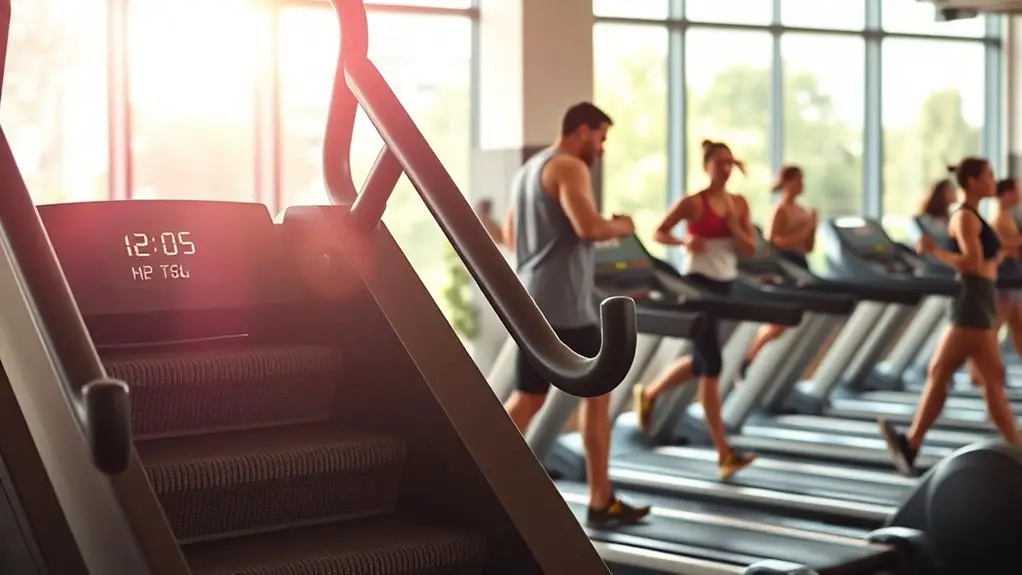
Understanding the calorie burn difference between a stair climber and a treadmill can help you choose the right equipment for your fitness goals. Both machines can provide an effective workout, but they do vary in intensity levels and calorie expenditure.
- Stair climbers typically engage more muscle groups, increasing calorie burn.
- Treadmills allow for varying speeds and inclines, which can enhance your workout intensity.
- Your weight and workout duration considerably affect the total calories burned.
- Safety is essential; make sure you’re familiar with the machine before starting.
- Consider your fitness level: stair climbers may be more challenging for beginners.
Ultimately, if you’re aiming for a higher calorie burn, the stair climber might be your best bet, especially if you can handle the intensity. However, treadmills offer versatility, letting you customize your workout to fit your comfort and safety needs.
Muscle Engagement Analysis
When comparing the stair climber and treadmill, it’s essential to look at how each machine engages your muscles differently. You’ll notice variations in muscle activation, especially in your lower body, and the degree of core engagement they provide. Understanding these differences can help you choose the best option for your fitness goals.
Muscle Activation Differences
As you compare a stair climber to a treadmill, it’s essential to recognize the distinct muscle activation patterns each machine promotes. The stair climber primarily engages your lower body muscle groups, like your quadriceps, hamstrings, and glutes, providing a great workout for your legs. In contrast, the treadmill offers a more balanced workout, activating muscle groups in both your upper and lower body, especially if you incorporate arm movements.
- Stair climber focuses on leg strength.
- Treadmill promotes overall muscle engagement.
- Stair climbers enhance glute activation.
- Treadmills allow for varied intensity levels.
- Both options can be safe when used correctly.
Understanding these activation patterns can help you choose the right machine for your fitness goals while ensuring your safety during workouts.
Core Engagement Comparison
While both the stair climber and treadmill engage various muscle groups, their impact on core engagement differs considerably. The stair climber requires you to stabilize your core to maintain balance as you ascend, enhancing core strength and stability. You’ll naturally engage your abdominal muscles, which can help improve overall posture and reduce injury risk.
On the other hand, while using a treadmill, your core is still involved, but the primary focus is on your legs. If you’re walking or running, you might not actively engage your core as much. For ideal core stability, consider incorporating exercises specifically targeting your core into your routine, regardless of the machine you choose. Prioritizing safety guarantees you’ll get the most effective workout.
Lower Body Focus
A stair climber and a treadmill each provide unique benefits for lower body muscle engagement. If your fitness goals focus on strength and endurance, incorporating both can enhance your lower body workouts.
- The stair climber targets glutes, quads, and hamstrings effectively.
- It encourages proper posture, which can reduce injury risk.
- You can adjust the intensity to match your fitness level.
- Treadmills offer versatility with incline options, engaging different muscle groups.
- Both machines can be used safely with proper footwear and technique.
Impact on Joint Health
When it comes to joint health, the type of workout you choose can make a big difference. Stair climbers generally offer a lower-impact option compared to treadmills, which can help reduce stress on your joints. Understanding these differences can help you make a more informed decision for your fitness routine.
Joint Stress Comparison
Joint stress is a critical factor to evaluate when choosing between a stair climber and a treadmill. Your joint mobility and safety should always come first. Here’s what you should consider:
- Stair climbers generally offer lower impact, which may be better for injury prevention.
- Treadmills can allow for a range of speeds and incline options, but might lead to higher joint stress.
- If you have existing joint issues, the stair climber could be a safer choice.
- Both machines promote cardiovascular health, but your comfort matters too.
- Always listen to your body—if you feel discomfort, switch it up to maintain joint health.
Ultimately, choosing the right machine can help you stay active while protecting your joints.
Low-Impact Benefits
Stair climbers shine when it comes to low-impact workouts that benefit joint health. If you’re looking for joint-friendly workouts, stair climbers offer a safer alternative to treadmills. They provide an effective way to strengthen your legs and glutes while keeping stress off your knees and hips.
| Exercise Type | Joint Impact Level | Safety Rating |
|---|---|---|
| Stair Climber | Low | High |
| Treadmill Running | Moderate | Medium |
| Walking on Treadmill | Low | Medium |
With stair climbing, you can engage in low impact exercises that minimize the risk of injury. Remember, choosing the right equipment is essential for maintaining joint health while achieving your fitness goals.
Workout Variability and Options

While both stair climbers and treadmills offer effective workouts, they provide different options for variability that can enhance your fitness routine. If you’re looking to incorporate workout variety based on your exercise preferences, here are some features to take into account:
- Incline Settings: Treadmills let you adjust the incline, simulating hills for a more intense workout.
- Interval Training: Both machines allow for interval workouts, but stair climbers can be more engaging with alternating speeds.
- Time-Based Goals: You can set specific time challenges on either machine to keep your workouts fresh.
- Resistance Levels: Stair climbers often have adjustable resistance, allowing for tailored challenges that suit your fitness level.
- Cross-Training Options: You can mix in bodyweight exercises or strength training after cardio sessions for a well-rounded routine.
Choosing between these options can help you maintain motivation while prioritizing safety in your workouts.
User Experience and Comfort
When you think about user experience and comfort, body position and stability play a big role in how enjoyable your workout is. You’ll also want to take into account the noise and impact levels of each machine, as these factors can greatly affect your overall experience. Let’s explore how these elements compare between the stair climber and treadmill.
Body Position and Stability
Choosing between a stair climber and a treadmill often comes down to how your body feels during the workout. Stability and body position are essential for ensuring a safe and effective session. On a stair climber, your body’s natural posture alignment is supported, which can enhance your balance techniques. Meanwhile, treadmills may require more effort to maintain stability, especially at higher speeds.
- Stair climbers promote a natural upright position.
- Treadmills can lead to slouching if not monitored.
- Both machines enhance muscle engagement.
- Focus on maintaining balance to prevent injuries.
- Adjusting equipment settings can improve comfort.
Ultimately, your choice should factor in which machine lets you feel secure and aligned while you exercise.
Noise and Impact Levels
Although both stair climbers and treadmills offer effective workouts, the noise and impact levels can greatly affect your user experience and comfort. Here’s a quick impact assessment to help you decide:
| Equipment | Noise Levels |
|---|---|
| Stair Climber | Low |
| Treadmill | Moderate |
| Impact Level | |
| Stair Climber | Low |
| Treadmill | High |
Stair climbers typically produce less noise, making them ideal for shared spaces. Their lower impact on joints also guarantees a safer workout experience. On the other hand, treadmills can create more noise and have a higher impact level, which might not be suitable for everyone. Choosing the right option will enhance your workout comfort and safety.
Space and Cost Considerations
While both stair climbers and treadmills offer effective workouts, their space and cost considerations can differ considerably. If you’re tight on space, a stair climber tends to be more space-efficient, making it a great option for smaller areas. On the other hand, treadmills can require more room and might not fit well in compact living spaces.
For cost analysis, treadmills often have a wider price range, while stair climbers can be more budget-friendly. Here’s a quick breakdown:
- Stair Climbers: Usually occupy less space.
- Treadmills: Can be bulkier and need extra room.
- Cost: Stair climbers often cost less than treadmills.
- Maintenance: Treadmills may require more upkeep due to moving parts.
- Safety: Both machines should have safety features, but stair climbers might pose less risk of falls in confined areas.
Ideal Users for Each Machine
When it comes to selecting the right machine, understanding who will benefit most from each option is key. If you’re a beginner user, treadmills might be your best bet, offering a familiar walking or running motion that’s easy to grasp. They’re great for cardio fitness and weight loss, allowing you to control speed and intensity as you build endurance.
On the other hand, if you’re an athletic user looking to enhance strength training, the stair climber provides a more intense workout, targeting specific muscle groups while elevating your heart rate. It’s also advantageous for rehabilitation purposes, as it offers low-impact movement options.
Consider convenience factors and your workout preferences too. If you enjoy variety, a treadmill’s versatility can keep things interesting. But if you prefer a focused challenge, the stair climber might be more appealing. Choose based on your goals and comfort level to guarantee a safe and effective workout.
Final Thoughts on Choosing the Right Equipment
Ultimately, choosing the right equipment boils down to your personal fitness goals and exercise preferences. Both the stair climber and treadmill offer unique benefits, so it’s crucial to reflect on what aligns best with your needs.
Here are a few things to keep in mind:
- Safety First: Verify the equipment feels stable and secure before using it.
- Comfort Level: Choose a machine that you enjoy using to stay motivated.
- Workout Variety: Contemplate how each machine can fit into your overall fitness routine.
- Space Considerations: Assess the available space in your home or gym for the equipment.
- Budget: Evaluate your financial limits when making a decision.
Frequently Asked Questions
Can I Use a Stair Climber for HIIT Workouts?
Yes, you can definitely use a stair climber for HIIT workouts! It allows you to increase your workout intensity, which is key for getting the most out of HIIT benefits. Just be sure to start at a comfortable level and gradually increase your speed or resistance to avoid injury. Always listen to your body, and take breaks if you need them. This way, you can enjoy a safe and effective workout session!
How Do I Maintain My Treadmill for Longevity?
Imagine you’ve got a friend who uses their treadmill daily but neglects maintenance. Over time, it starts to squeak and eventually breaks down. To avoid that, focus on routine care. Regularly check the belt alignment to guarantee it runs smoothly. Don’t forget to apply treadmill lubrication to reduce wear and tear. This’ll not only enhance performance but also extend your machine’s life, keeping your workouts safe and effective for years to come.
Are There Any Age Restrictions for Using These Machines?
When it comes to using exercise machines, age guidelines can vary. Generally, there’s no strict age restriction, but user recommendations suggest that younger users should be supervised. For older adults, it’s essential to consult with a healthcare provider before starting any new exercise routine. This guarantees safety and prevents injury. Always listen to your body and adjust workouts based on your fitness level, regardless of your age.
Can I Watch TV While Using a Stair Climber?
Imagine climbing a mountain while catching up on your favorite show—now that’s multitasking at its finest! You can absolutely watch TV while using a stair climber, but make sure you’re safe. Keep the volume at a comfortable level so you can hear any surrounding sounds. Balance is key; focus on your form to avoid injury. With the right approach, you can enjoy watching entertainment while still getting a solid workout.
What Safety Features Should I Look for in These Machines?
When considering safety features in fitness machines, you should prioritize machine stability. Look for a model that has a wide base and anti-slip surfaces to prevent accidents during use. Additionally, check for emergency stop buttons and adjustable settings that allow you to control speed and intensity safely. Handrails are also essential for balance, especially if you’re new to exercising. Always guarantee the machine meets safety standards for your peace of mind.


